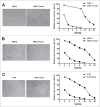MiR-1204 sensitizes nasopharyngeal carcinoma cells to paclitaxel both in vitro and in vivo
- PMID: 25756509
- PMCID: PMC4622873
- DOI: 10.1080/15384047.2014.1001287
MiR-1204 sensitizes nasopharyngeal carcinoma cells to paclitaxel both in vitro and in vivo
Abstract
Nasopharyngeal carcinoma (NPC) is an endemic tumor with a relatively high incidence in Southern China and Southeast Asia. Paclitaxel combination chemotherapy has been used for treatment of advanced NPC. However, treatment failure often occurs due to development of acquired paclitaxel resistance. In this study, we first established a paclitaxel-resistant CNE-1/Taxol, HNE-2/Taxol and 5-8F/Taxol cell sublines by treating the parental CNE-1, HNE-2 and 5-8F cells with increasing doses of paclitaxel for about 5 months, respectively. Then, microRNA arrays were used to screen differentially expressed miRNAs between the CNE-1/Taxol cells and the parental CNE-1 cells. We found 13 differentially expressed miRNAs, of which miR-1204 was significantly downregulated in the paclitaxel-resistant CNE-1/Taxol cells. We restored miR-1204 expression in the CNE-1/Taxol, HNE-2/Taxol and 5-8F/Taxol cells and found that restoration of miR-1204 re-sensitized the paclitaxel-resistant CNE-1/Taxol, HNE-2/Taxol and 5-8F/Taxol cells to paclitaxel both in vitro. Finally, we demonstrated that restoration of miR-1204 in significantly inhibits tumor growth in vivo. Thus, our study provides important information for the development of targeted gene therapy for reversing paclitaxel resistance in NPC.
Keywords: EBV, Epstein-Barr virus; Lv-miR-1204, Lentiviruses containing miR-1204; NPC, nasopharyngeal carcinoma; chemotherapy; miR-1204; miRNAs, MicroRNAs; microRNAs; nasopharyngeal carcinoma; paclitaxel.
Figures





References
-
- Fahraeus R, Fu HL, Ernberg I, Finke J, Rowe M, Klein G, Falk K, Nilsson E, Yadav M, Busson P, et al. . Expression of Epstein-Barr virus-encoded proteins in nasopharyngeal carcinoma. Int J Cancer 1988; 42:329-38; PMID:2843473; http://dx.doi.org/10.1002/ijc.2910420305 - DOI - PubMed
-
- Wee JT, Ha TC, Loong SL, Qian CN. Is nasopharyngeal cancer really a "Cantonese cancer"? Chin J Cancer 2010; 29:517-26; PMID:20426903; http://dx.doi.org/10.5732/cjc.009.10329 - DOI - PubMed
-
- Jordan MA, Wilson L. Microtubules as a target for anticancer drugs. Nat Rev Cancer 2004; 4:253-65; PMID:15057285; http://dx.doi.org/10.1038/nrc1317 - DOI - PubMed
-
- Rowinsky EK. The development and clinical utility of the taxane class of antimicrotubule chemotherapy agents. Ann Rev Med 1997; 48:353-74; PMID:9046968; http://dx.doi.org/10.1146/annurev.med.48.1.353 - DOI - PubMed
-
- He XY, Hu CS, Ying HM, Wu YR, Zhu GP, Liu TF. Paclitaxel with cisplatin in concurrent chemoradiotherapy for locally advanced nasopharyngeal carcinoma. Eur Arch Oto-Rhino-Laryngol 2010; 267:773-8; PMID:19820959; http://dx.doi.org/10.1007/s00405-009-1112-7 - DOI - PubMed
Publication types
MeSH terms
Substances
LinkOut - more resources
Full Text Sources
Other Literature Sources
